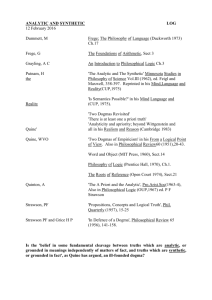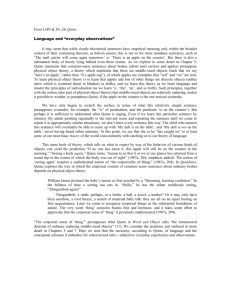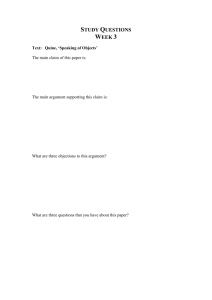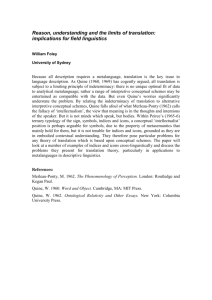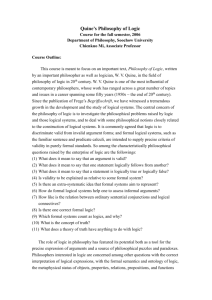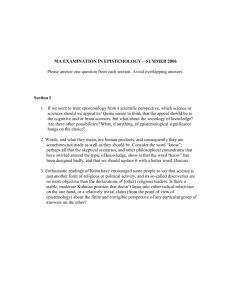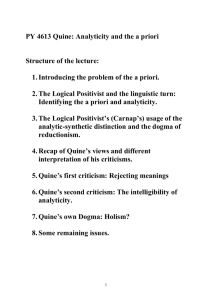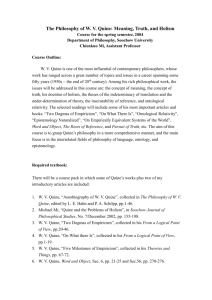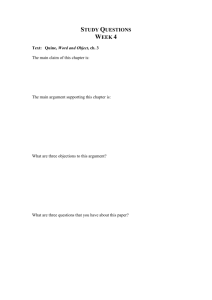Quine on the Analytic/Synthetic Distinction
advertisement
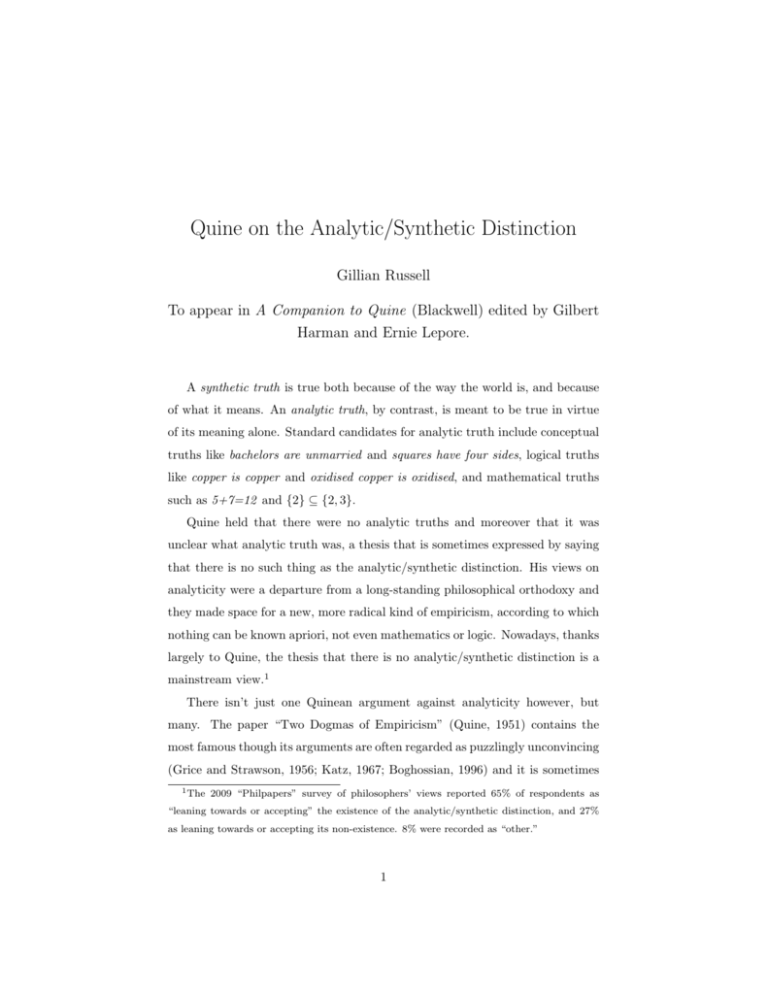
Quine on the Analytic/Synthetic Distinction
Gillian Russell
To appear in A Companion to Quine (Blackwell) edited by Gilbert
Harman and Ernie Lepore.
A synthetic truth is true both because of the way the world is, and because
of what it means. An analytic truth, by contrast, is meant to be true in virtue
of its meaning alone. Standard candidates for analytic truth include conceptual
truths like bachelors are unmarried and squares have four sides, logical truths
like copper is copper and oxidised copper is oxidised, and mathematical truths
such as 5+7=12 and {2} ⊆ {2, 3}.
Quine held that there were no analytic truths and moreover that it was
unclear what analytic truth was, a thesis that is sometimes expressed by saying
that there is no such thing as the analytic/synthetic distinction. His views on
analyticity were a departure from a long-standing philosophical orthodoxy and
they made space for a new, more radical kind of empiricism, according to which
nothing can be known apriori, not even mathematics or logic. Nowadays, thanks
largely to Quine, the thesis that there is no analytic/synthetic distinction is a
mainstream view.1
There isn’t just one Quinean argument against analyticity however, but
many. The paper “Two Dogmas of Empiricism” (Quine, 1951) contains the
most famous though its arguments are often regarded as puzzlingly unconvincing
(Grice and Strawson, 1956; Katz, 1967; Boghossian, 1996) and it is sometimes
1 The
2009 “Philpapers” survey of philosophers’ views reported 65% of respondents as
“leaning towards or accepting” the existence of the analytic/synthetic distinction, and 27%
as leaning towards or accepting its non-existence. 8% were recorded as “other.”
1
said that the real force of Quine’s attack on the analytic/synthetic distinction is
to be found in “Truth by Convention” and “Carnap and Logical Truth” (Quine,
1936b; 1954). In the pages that follow I will argue there is are ways to reconstruct the arguments from “Two Dogmas” that make them effective against
at least some historically significant construals of analyticity, and that, taken
together with the arguments from (Quine, 1936b) and Quine (1954) they set
non-trivial limits on the kind of property analyticity can be.
1
Making sense of “Two Dogmas of Empiricism”
“Two Dogmas” is one of the best-known articles in philosophy. Godfrey-Smith
writes that it is “sometimes regarded as the most important [article] in all of
twentieth-century philosophy” and Creath that it “is perhaps the most famous
paper in twentieth-century philosophy.” (Creath, 2004) The paper’s central thesis is that there is no analytic/synthetic distinction; the claim that there is one
is the first of the alleged dogmas of the title, while Quine says that the second
is “at root identical” to the first, so that really “Two Dogmas” has a single target: the analytic/synthetic distinction. (Quine, 1951: 38) There are two main
arguments in the paper: the Circularity Argument, and the Argument from
Confirmation Holism.
The Circularity Argument
In the first part of “Two Dogmas” Quine examines a variety of historical attempts to define analyticity and rejects each as failing to live up to then contemporary standards of clarity, rigour, and metaphysical austerity. He also
attempts his own chain of definitions, a chain which ultimately leads to disaster in purported circularity and his conclusion that there is no such thing as
analyticity.
He proposes, to begin with, that we define analyticity in terms of synonymy:
Definition 1 (Analytic) A claim is analytic if it may be transformed into a
2
logical truth by substituting synonyms for synonyms
But Quine then notes that such an account presupposes that we have understood the expression synonym and wonders how we are to define that. He
considers doing it in terms of definitions, of which he says there are three kinds—
lexigraphical definitions, explications and abbreviations—but that the first two
presuppose synonymy, rather than explaining it. Of the third he writes:
Here we have a really transparent case of synonymy created by
definition; would that all species of synonymy were as intelligible.
(Quine, 1951: 26)
Nonetheless Quine proposes that we forget about definitions and instead try to
explain synonymy in terms of necessity:
Definition 2 (Synonym) Two expressions are synonymous if they may be
substituted for each other in a sentence beginning ‘necessarily....’ without change
of truth-value.
But this strategy, he says, has an ‘air of hocus pocus’ because to suppose that
we have made sense of ‘necessarily’ “is to suppose that we have already made
satisfactory sense of ‘analytic’.” (Quine, 1951: 29) We should thus give up on
our attempts to define analyticity in terms of synonymy.
Though it was maintained by Carnap that things like synonymy and analyticity are well-defined only for artificial languages with precise “semantical rules”
(Sober, 2000) Quine maintains that these expressions do not make sense in this
domain either. For when we give rules for determining which of the sentences in
our logical language deserves the label analytic, we may either be attempting to
attribute an antecedently understood property—in which case Quine asks what
that property is, and we find ourselves back where we started—or we are introducing a new property and legislating its extension. In the latter case Quine
suggests that such predicate “might better be written untendentiously as ‘K’ so
as not to seem to throw light on the interesting word ‘analytic’.” (Quine, 1951:
32) He concludes:
3
... for all its a priori reasonableness, a boundary between analytic
and synthetic statements simply has not been drawn. That there is
such a distinction to be drawn at all is an unempirical dogma of
empiricists, a metaphysical article of faith. (Quine, 1951: 34)
The circularity argument raises some questions: Why does making sense
of necessarily presuppose that we have made sense of analytic? Why does
Quine’s failure to define analytic show that it does not make sense? If Quine
really doesn’t understand analytic (instead of just feigning incomprehension)
why aren’t his analyses worse than they are and why does he consider himself
competent to criticise the analyses of others? And, of course: if legislative definitions are transparent reports of synonymy, why isn’t this sufficient to show that
synonymy makes sense after all, with the result that we can define analyticity?
I’ll take these in turn.
Why does making sense of ‘necessarily’ presuppose making sense of
‘analytic’ ?
When dismissing attempts to explain synonymy in terms of necessity Quine says
that the analysis
“is not flatly circular, but something like it. It has the form,
figuratively speaking, of a closed curve in space.” (Quine, 1951: 29)
It is clear from the paper that he thinks such circularity is fatal, and also
that it is linked to the fact that he thinks that to make sense of necessity is
already to have made sense of analyticity. But the contemporary reader is
liable to wonder why Quine thinks his reader will accept that—that necessity
presupposes analyticity—without further argument.
Historical context provides the answer. The empiricists of Quine’s time
were logical positivists and a central tenet of that philosophy was the Linguistic
Doctrine of Necessary Truth. The idea is this: the positivists subscribe to
verificationism about meaning according to which a sentence is meaningful only
4
if there is data which could verify that it is true, or false. But the true sentences
of logic and mathematics—-things like It is not the case that John is both tall
and not tall and 5+7=12 —don’t fit with this verificationist picture very well.
Such claims are usually thought to be necessarily true, so that no datum could
disconfirm them, and their negations are thought to be impossible, so that
no experience could verify them. From an empiricist standpoint necessity can
seem both metaphysically problematic—what is it, after all?—and epistemically
problematic—how can data about the way things are tell us anything about how
they had to be? The Linguistic Doctrine of Necessary Truth is the positivist’s
solution to this problem. According to it, the true claims of arithmetic and logic
are analytic, or true in virtue of their meanings alone. This explains both their
necessity and our knowledge of it; if a sentence is true in virtue of its meaning
along, then it doesn’t matter what the world is like the sentence will still be
true—hence it is necessary. And if it is true in virtue of what it means, and (as
we’ll assume for argument’s sake) speakers are acquainted with the meanings
of the expressions they use, then they are likely to be able to work out that
the sentence has got to be true without experiencing of the world. Hence the
widespread belief amongst empiricists of the time: what it is to say that a truth
is necessary is to say that it is analytic.
And once we realise that, it becomes clear why Quine thinks an analysis
of analyticity that presupposes an analysis of necessity is inadequate: Quine is
assuming that the reason empiricists are interested in analyticity is because of
its ability to explain necessity. Since this account is not suitable for that, it
won’t suffice.
Why would the failure to define ‘analytic’ show that it does not make
sense?
Another puzzle is why the failure to find a definition of analyticity is taken to
be a serious problem for analyticity. Augustine discovered upon reflection that
he was unable to define time:
5
“For what is time? Who can easily and briefly explain it? ... If
no one ask of me, I know; if I wish to explain to him who asks, I
know not.” (Augustine, 1991)
but he did not conclude from that there was no such thing. So why is Quine
justified in drawing the stronger conclusion?
There are a variety of published solutions. (Grice and Strawson, 1956; Harman, 1999b; Boghossian, 1996; Harman, 1999a) An idea that regularly comes
up is that analytic, unlike time is a technical, philosophical expression, rather
than one that is entrenched in ordinary language. One might think that when a
word has been entrenched in ordinary language for an extended period there is a
default presumption that it is meaningful, so that substantial work is needed to
show that it isn’t. With newer, or more technical expressions, however, history
and established practice have less weight, and so less is needed to justify the
conclusion that the expression is meaningless.
This has a certain plausibility. Certainly if analytic were brand new—if the
author of a new paper had just invented it—you would expect them to define
it, and if they did not there would be reason to suspect that the predicate had
no meaning at all, since there had been nothing to give it one. Moreover if the
author offered a definition, but we then discovered a flaw in the definition that
made it incoherent or ineffective, then too, we would have grounds to think the
expression problematic.
Older expressions from natural languages, like time, really are different. Native speakers usually learn them through exposure to many instances of use,
rather than through an explicit definition. It isn’t surprising then if their knowledge of the meaning is largely implicit and difficult to make explicit. With these
kinds of expression it is unsurprising that one speaker finds it hard to lay out
an explicit definition, and so this provides no evidence that that the expression
is meaningless.2
2 Even
entrenched expressions may nonetheless turn out to be empty or meaningless. I
take it that STR showed that ‘simultaneous’ (in the absolute sense) was empty and Russell’s
paradox that the naive ‘∈’ was meaningless.
6
Nonetheless, analytic is hardly brand new. It has been in use in philosophy
for centuries. Perhaps that history of usage—whilst not giving it the respectability of time—should count for something. Grice and Strawson suggest a different
response. (Grice and Strawson, 1956) They point out that even if analytic is
a somewhat philosophical expression, Quine has already conceded that it can
be defined in terms of synonymy or equivalently, using the words means the
same as, and they argue that this is a part of ordinary language—not a new
technical expression at all. Given that means the same as is meaningful, and
analytic can be defined in terms of it and other uncontroversially meaningful
expressions, analytic must be meaningful as well.
One response on Quine’s behalf is to argue that it is a mistake to think that
the sense of means the same which is adequate to defining analyticity is the
same as the one that we find in ordinary language:
When philosophers say that analytic truths are those truths that
are synonymous with or mean the same as truths of logic, they use
‘synonymous’ and ‘mean the same’ as technical expressions. They
do not use these expressions in their ordinary sense. One has only to
examine a dictionary of synonyms in order to appreciate this point
with respect to ‘synonym.’ (Harman, 1999b: 124–4)
Certainly philosophers attempt to be more careful with their uses of means
the same than ordinary speakers have any need to be. And while it is not
obvious that this means that they are using the expression with a different,
technical meaning—perhaps doctors use the expression arthritis with more care
than ordinary speakers (Burge, 1979), but it isn’t clear that they are using
different senses of the word—ultimately even well-entrenched expressions could
turn out to be meaningless and neologisms perfectly meaningful. Perhaps, for
the sake of argument, we should concede that analytic is a newish technical
expression and just come right out and ask: how is the case against it supposed
to work?
7
Kinds of Meaning
It will be helpful at this point to distinguish three different senses of meaning.
Only one of these is explicitly acknowledged by Quine in the paper, but all
three, I think, play a role in the best explicit reconstruction of the circularity
argument.
So first, sometimes we say that an expression is meaningful if it has significance for people, where this is usually a consequence of our having a practice of
using it to do certain things. In this sense ‘hello’ has meaning, even though there
is no object in the word that it is supposed to ‘mean’. In this minimal sense it
is clear that ‘analytic’ does have meaning, and had meaning when Quine was
writing, since it was in use. We might call this easily-obtained kind of meaning
‘meaning-lite.’ Even Quine, then, can agree that analytic has meaning-lite.
But meaning-lite isn’t always what we have in mind when we talk about
meaning. Often we have in mind the thing, or set of things that the expression
picks out: its referent or extension (in this context no harm will come from using
these words interchangably.) This second level of meaning is one that Quine
explicitly acknowledges in ‘Two Dogmas’ (though in ‘Two Dogmas’ he prefers
to reserve the word ‘meaning’ for intensional notions.)
Quine thinks that analytic has no extension at all. It isn’t just that there
turned out to be no analytic truths so that analytic takes the empty set as its
extension, rather he thinks that no good mechanism has been established which
would link the expression to a suitable extension. ‘Analytic’ on Quine’s view
has no extension because its meaning—in a third sense—is unclear.
And so a third thing that gets called meaning is the mechanism or rule that
establishes the extension of the predicate. Strings of letters are not born with
extensions, they have to be specified somehow. To be clear, I am not assuming
that this rule is always known, far less known explicitly, to competent speakers. I
take what I’m saying to be compatible with semantic externalism. But extension
determination is not magic, and if an expression has an extension, that extension
gets determined somehow, whether that be though explicit definition, causal
8
chain, or something else.
Does Quine think that ‘analytic’ is meaningful in this third sense? I think
he would say that its meaning in this sense is defective: the rule for determining
its extension is problematic—it doesn’t work as it should—and so it fails to
determine an extension.
An example will illustrate the phenomenon. Suppose I introduce a new
technical term—strice—in a paper and define it thus “a strice is a number that
divides a grison with no remainder.” Then I have apparently provided a rule
to determine what does and does not fall in the extension of strice. I’ve given
strice a meaning in the third sense of the word. But when we look closer we
encounter a problem, for the rule exploits another technical term—grison—and
as a result strice can only have a well-defined extension if grison does. Happily,
I provide a rule/definition for this expression too: a grison is a number that can
be divided by a strice with no remainder.
It should be obvious that this will not do. The extension-determining rule
for strice depends upon that of grison and vice versa, and now it seems clear
that successful extension-determining must meet a certain constraint: it cannot
be circular; circular extension determination is ungrounded—it fails to latch
onto the world in the expected way.
So now I’d like to suggest a specific interpretation of the thesis of Quine’s
circularity argument. There are three parts to it:
1. analytic may well have meaning-lite, but
2. the rule for determining the extension of analytic is defective in a fatal
way—it is circular—and as a result,
3. analytic does not have an extension
My argument that this is Quine’s view—despite the fact that he doesn’t set
it out this explicitly—is that attributing this view to him allows us to solve some
puzzles about the circularity argument, as well as clarify why the argument has
some force.
9
If Quine doesn’t understand ‘analytic’, why isn’t his analysis of it
worse?
Quine claims not to understand analytic or synonymous but if what he says
is true, it is hard to see why his attempts at analysing the expressions aren’t
worse; it never occurs to Quine that something might be analytic if and only if
it is an elephant, for example. This much accuracy can perhaps be explained
by his acquaintance with the meaning-lite of analytic; Quine is a philosopher,
he knows how the expression was used historically by Kant, Frege, Carnap etc.
and this is enough to make it clear that analytic is a property of truths, and
not animals. (Perhaps some sociopaths do really understand the word nostalgia
but even they know that it is supposed to be a feeling, and not a type of rock.)
But Quine’s confident analyses of the meaning of analytic and criticisms of
the analyses of others go beyond what we would expect him to have just from
being immersed in the philosophical world:
“There are those who find it soothing to say that the analytic
statements of the second class reduce to those of the first class,
the logical truths, by definition; ‘bachelor’ is defined as ‘unmarried
man’. But how do we find that ‘bachelor’ is defined as ‘unmarried
man’ ? Who defined it thus and when? Are we to appeal to the
nearest dictionary...? Clearly this would be to put the cart before
the horse.” (Quine, 1951: 24)
“A natural suggestion, deserving close examination, is that the
synonymy of two linguistic forms consists simply in their interchangeability in all contexts without change of truth-value ... But it is not
quite true that the synonyms ‘bachelor’ and ‘unmarried man’ are
interchangable salva veritate.” (Quine, 1951: 27)
Quine says that analytic, synonymous and meaning are meaningless, but
he writes like someone who understands them perfectly well and is gradually
working his way towards an explicit account of what it is to be analytic, synony10
mous, meaningful etc. A natural explanation of what is going on here is that he
(implicitly) takes himself to be acquainted with the rules that are meant to determine the extensions of these expressions, so that he ‘knows what they mean’
in the third sense of ‘mean’. He works towards making those explicit much as
any philosopher might, and his crucial insight is that doing so reveals that the
rules are defective: the circularity that he discovers means that expressions like
analytic, meaning etc. are ungrounded and have no extension (no meaning in
sense 2). Hence this interpretation makes sense of Quine’s claim that analytic is
not meaningful, as well as the claim that its meaning is defective, and the manifest fact that in some sense Quine knows perfectly well what the expressions
mean.
This interpretation also, finally, offers a solution to our puzzle from two
sections ago. Why does Quine’s failure to define analytic show that it cannot
be defined, even though Augustine’s failure to define time did not show that it
cannot be defined? Because Quine does not simply take himself to be casting
about for any possible definition of analytic. He thinks he has the right one—the
right rule for determining whether or not a sentence is analytic—it is just that
he also thinks he has shown that that rule is circular and hence defective.
If abbreviating definitions are transparent cases of synonymy, why
can’t synonymy be used to analyse analyticity ?
A final puzzle concerning ‘Two Dogmas’ is what we are to make of Quine’s
admission that synonymy—in the case of abbreviating definitions—really does
make sense after all. The problem is that Quine seems to accept all of:
• if there is such a thing as synonymy, then there is a satisfactory analysis
of analyticity in terms of it
• abbreviating definitions are transparent cases of synonymy (so there is
such a thing)
• there is no satisfactory analysis of analyticity
11
The inconsistency is so blatant that critics often either choose to ignore it completely, as Grice and Strawson do:
“Now if we are to take these words of Quine seriously, then his
position as a whole is incoherent ... perhaps we should not take
Quine’s words here too seriously.” (Grice and Strawson, 1956: 153)
or else they struggle to come up with a coherent interpretation and end up with
something that seems too difficult to defend to have been something that Quine
could reasonably have thought he could maintain without argument in ‘Two
Dogmas’:
“So his skepticism about synonymy has to boil down to the following somewhat peculiar claim: Although there is such a thing as
the property of synonymy; and although it can be instantiated by
pairs of tokens of the same orthographic type; and although it can
be instantiated by pairs of tokens of distinct orthographic types,
provided that they are related to each other by way of an explicit
stipulation; it is, nevertheless, in principle impossible to generate
instances of this property in some other way, via some other mechanism....” (Boghossian, 1996)
A further possibility—one which has support both from Quine’s explicit views
on definition elsewhere (Quine, 1954) and Harman’s sympathetic presentation
of Quine’s views on meaning and analyticity in (Harman, 1999b;a)—is that the
type of analyticity that one would get from the synonymy provided by abbreviating definitions is not a type of analyticity that will do the work empiricists
have cut out for it. From even before the time of ‘Two Dogmas’ Quine stressed
that definitions were used for convenience, something that allowed a theory—
especially a theory of logic or mathematics—to written more concisely and which
could be dropped or altered anytime without loss to the theory. (Quine, 1936a:
47) At this point he seems to have thought this was obvious, but in later work
Quine came to emphasise the transience of definition:
12
The distinction between the legislative and the discursive refers
thus to the act, and not to its enduring consequence, in the case of
postulation as in the case of definition...Conventionality is a passing trait, significant at the moving front of science but useless in
classifying the sentences behind the lines. It is a trait of events not
sentences. (Quine, 1954: 112)
Being a definition, and hence a source of synonymy and analyticity, is not,
says Quine, an enduring trait of truths, but rather a transient fact, a feature
of the history of a sentence. There is much more to be said about Quine’s
views on the transience of definition3 but one way to make sense of Quine
on abbreviating definitions in ‘Two Dogmas’ is with the thought that since
abbreviating definitions are transient, and the logical positivists require a kind
of analyticity that is not, abbreviating definitions will not suit their purposes.
The Argument from Confirmation Holism
We can reconstruct a different argument against the analytic/synthetic distinction from the final sections of ‘Two Dogmas’. Quine assumes a prima facie
plausible epistemic position sometimes called confirmation holism. He observes
that when we are confronted with evidence that conflicts with a particular hypothesis, it is often possible to maintain that hypothesis if we are prepared to
adjust our commitments in other places. One might ignore a questionable experimental result, for example, if one is prepared to adjust one’s beliefs about
the reliability of the equipment used in the experiment. Generalising, Quine
suggests that sentences are never confirmed or disconfirmed in isolation; rather
it is entire theories of the world, or ‘webs of belief’ that receive confirmation or
disconfirmation when we examine data.
P1
Confirmation holism: it is only entire theories, not individual sentences,
which are confirmed or disconfirmed by data.
3 See
e.g. (Russell, 2008: 143–162) for more.
13
The second premise in the argument is another tenet of logical positivism,
namely, the verification theory of meaning, according to which the meaning
of a linguistic item is an ordered pair of sets of data, namely, the set of data
that would confirm it, and the set that would disconfirm it.
P2
Verificationism about Meaning: the meaning of a linguistic item is the
set of data that would confirm it paired with with the set of data that
would disconfirm it.
From just these two premises it is already clear that Quine is suggesting that
confirmation holism ought to lead the positivists to a radical new conception
of meaning. Strictly speaking, they ought to think that single sentences in
isolation do not have a meaning, since they are not susceptible to confirmation
or disconfirmation. Rather it is entire theories which have meaning:
C1
Isolated sentences do not have meanings. Only entire theories have
meanings.
Quine does draw this conclusion explicitly, but his focus in ‘Two Dogmas’ paper is on the analytic/synthetic distinction, and so he draws out some of the
consequences of the verificationism/confirmation holism fusion for analyticity.
Given verificationism about meaning, he thinks it is natural for us to define an
analytic sentence in a slightly unfamiliar way, as one which is confirmed come
what may:
P3
An analytic sentence is one which is confirmed come what may.4
But on the new picture sentences are not the kind of thing that can be confirmed,
nevermind confirmed come what may, and so Quine can say
4 It
might be tempting here to point out that Quine appears to have found an acceptable
definition of analyticity. We might offer the following dilemma: either this definition is good,
and analyticity makes sense, or it isn’t any good, and the argument from confirmation holism
is unsound. But again I think the right interpretation here is to think of Quine as suggesting
that this is an accurate definition in that it gives the actual rule for determining the extension
of analytic, but observing that this rule is problematic, since there are no sentences which get
confirmed at all, nevermind come what may.
14
C2
There are no analytic sentences.
Worse that this, the whole idea of a sentence that would be confirmed come
what may seems to have been confused:
“...it becomes folly to seek a boundary between synthetic statements, which hold contingently on experience, and analytic statements which hold come what may. Any statement can be held true
come what may, if we make drastic enough adjustments elsewhere in
the system. Even a statement very close to the periphery can be held
true in the face of recalcitrant experience by pleading hallucination
or by amending certain statements of the kind called logical laws.
Conversely, by the same token, no statement is immune to revision.
Revision even of the logical law of the excluded middle has been
proposed as a means of simplifying quantum mechanics;...” (Quine,
1951)
A second picture
There are some obvious ways to challenge this deductive argument against the
analytic/synthetic distinction. Philosophers of science have disputed the first
premise (Sober, 2000), verificationism is anathema to most philosophers of language, and the definition of analyticity will seem sloppy to contemporary readers
since it fails to distinguish it from necessity or apriority.
So personally I am inclined to think all three of the premises in the Argument
from Confirmation Holism are false. But to leave things there would be to miss
something important about the epistemic force of the last part of ‘Two Dogmas’;
sometimes a philosophical picture of how things work gains currency—whether
or not there are good arguments in its favour—because it is hard for anyone
to imagine that things could be any other way. If that picture also seems to
provide needed solutions to central philosophical problems—such as how we
know mathematical truths, or the nature of necessity—then it can be very hard
to dislodge; even deductively valid arguments against the view may be demoted
15
to the status of ‘problems’ rather than refutations. But one of the ways such a
resiliant picture can be undermined is through the elaboration of a reasonable
alternative. Just the existence of the alternative has a tendency to rob the
dominant picture of its sense of inevitablity, and philosophers who might earlier
have shrugged their shoulders and accepted it will now shrug their shoulders
and withhold judgement.
Logical positivism was not the only view around when Quine was writing, but
for a philosopher of a certain bent, for whom rationalism and Kantianism were
things to be escaped from, it might well have been the only attractive one. And
so the last part of ‘Two Dogmas’ does more than merely present an additional
argument against the analytic/synthetic distinction, it presents a new picture of
how the world—but more especially epistemology in the world—can work, and
offers an alternative account of the status of logical and mathematical truths.
Whenever we encounter what Quine calls a ‘recalcitrant’ experience, one which
does not fit with our overall theory of the word, there will be—consistently
with confirmation holism—several different ways to adjust that web so that it
no longer conflicts with the new datum. But some of these ways will strike
us as better than others; we would be concerned for the sanity of scientist
who responded to the first piece of unwelcome evidence by concluding that the
information stream from his eyes to his brain was being manipulated by aliens,
or that the sum of 2 and 2 was no longer 4, even if those moves would bring his
overall theory of the world back into harmony with the data. Quine suggests
that the reason for this is that we are inclined to favour changes which comply
with principles of conservativeness and simplicity (and it seems clear that he
could allow more such principles.) (Quine, 1951: 43) It seems clear that theory
which included a sudden belief in aliens with an interest in controlling our visual
streams would not be very conservative compared to one which one which revised
the original only by giving up the hypothesis being tested, or giving up a belief
in the integrity of the scientist’s equipment. Similarly, giving up the belief
that 2+2=4 would presumably complicate our theory a great deal. It would
require changes to our theory of subtraction, changes to the way we compute
16
the bill in restaurants, changes to our beliefs about the appropriate way to work
out how many children, or limbs, certain people and animals have. So here
is the proffered explanation of the status of mathematical and logical truths:
it is extremely unlikely that we will relinquish them, given our commitments
to simplicity and conservatism in belief change. We have had a tendency to
exaggerate this status to being such that they will be confirmed come what
may. But really they are just much less likely to be given up than statements
at the periphery of the web such as there are brick houses on Elm Street.
A Third Picture
The most powerful part of the end of ‘Two Dogmas’ is the presentation of an
alternative worldview. So rather than argue against specific premises in the
deductive argument I reconstructed, let me finish this section by outlining a
third worldview that differs from both that of the positivists, and also from
that of Quine.
One thing that both the positivists and Quine’s views have in common is
the assumption that the epistemological, semantic and metaphysical distinctions all track together. (Kripke, 1980; Burgess, 1997; Soames, 2003) For the
positivists there are two kinds of truth, the apriori/analytic/necessary ones and
the aposterori/synthetic/contingent ones, but for Quine only the latter. Let’s
drop the assumption. Confirmation holism is a view in epistemology. A central
strand in that view is that it is entire theories—since I’m less worried about
abstracta than Quine was I’m tempted to say entire models, or pictures of how
things are—that are confirmed or disconfirmed by observation. Quine’s radical
suggestion was that that was how things worked in mathematics and logic as
well. And, on reflection, I now think that is quite plausible when it comes to
logic.
Consider, for example, a typical story about how someone comes to be justified in believing the law of excluded middle, i.e. in believing that for all values
of P , P ∨ ¬P is true. It’s almost always presented to us explicitly for the first
17
time in an introductory logic class. There it is (usually, though not always)
presented as part of a powerful theory—classical truth-functional logic. Prior
to acquaintance with this theory, most people’s explicit theorising with regard
to logic is limited to slogans from detective stories like “you can’t prove a negative” and some fuzzy ideas about it being bad to generalise. There is simply
no contest between such inchoate thoughts and the new theory: classical logic
explains the special status of things like P ∨ ¬P , P → P , ¬(P ∧ ¬P ) and also
other logical properties, such as consequence, equivalence and inconsistency. It
offers methods for detecting the presence of these properties in less intuitive
cases, such as Pierce’s law or modus tollens. Familiarity with it makes it easier
to follow proofs in other classes (contraposition in proofs in physics, when it’s ok
to use reductio in informal proofs in math.) It can be extended with quantifiers
to make it even stronger. Classical logic is a beacon of theoretical virtue: it
unifies different phenomena, explains new cases, is simple, useful and general.
It’s no wonder that students to whom it is first presented, who know of no other
alternative beyond some pretheoretic floundering, accept it and with it the law
of excluded middle. If you asked them why they accept the law, they are likely
to provide a real argument: Look, P can only be true, or false, right? If it’s true,
then P ∨ ¬P is true, given the truth-clause (the ‘semantics’) for disjunction. If
false, then ¬P is true given the truth-clause for negation, and again P ∨ ¬P is
true. We may even think that the justification for the belief is based on facts
about the meanings of the connectives, that it is derived from them.
Consider, however, how such a belief might come to be revised. A professor
(Professor 2) in another class challenges the assumption that P is either true
or false. Armed with the paradoxes of vagueness, the she argues that sentences
may lack a truth-value. But crucially, she doesn’t stop there. She provides a
new theory, one on which sentences may have one of three values, true, false or
neither, she specifies some designated values, and then demonstrates how to use
truth-tables to determine whether the logical properties of validity, consequence,
equivalence and inconsistency apply.
Our subject mulls this over for a while and eventually comes to believe
18
a new view: the logic that he learned in intro class is unable to deal with
the recalcitrant cases from vagueness. The three-valued logic has many of the
benefits of the old logic—it explains why certain sentences are special, why
certain arguments are good etc—and it continues to do so in a general, unifying,
useful way and unlike the old logic, it can handle the case where S has no truthvalue. The new picture is better, he decides and he switches to it, and in the
process gives up his belief in the law of excluded middle. Working in this new,
weaker logic turns out to be difficult sometimes; he occasionally yearns for the
days when he could employ the law of excluded middle, or double negation
elimination, in his proofs, but, he recalls, there are good reasons not to use
them; sometimes there are weapons that the good guys aren’t allowed to touch.
And now finally consider how he might come to revise his beliefs once again.
Another professor (Professor 3) tells him about various paradoxes, such as the
Liar, argues that their conclusions are both true and false. She too offers a
three-valued logic, with many of the familiar virtues, but this time the third
value is ‘both’. She points out to our subject that he was convinced by similar
arguments to give up the assumption that sentences had to have a truth-value.
So, now, the Professor 3 maintains that, for consistency’s sake, our subject
should give up the assumption that sentences cannot have more than one.
Our subject agrees with Professor 3 that the case for adopting a paraconsistent logic is about as good as the case for adopting an intuitionist one, but the
experience of working with a weakish logic has sensitised him to the difficulties
this involves. He knows that if he accepts the new argument he will loose even
more useful tools. The parallels between the problem with vagueness and the
problem with contradictions lead him to think that he might have started down
a slippery slope when he gave up classical logic. Maybe he gave in too easily?
Perhaps the natural domain of logic is sentences which have a truth-value. Or
perhaps he needs a new view of vagueness. Here’s one way to respond to the
two similar worries in similar ways: instead of moving on to a logic that is both
intuitionist and paraconsistent, he’ll go back to classical logic. And that’s what
he does, reacquiring his belief that the law of excluded middle is a logical truth
19
in the process.
I am less interested in the details of this case—it doesn’t matter, for example,
that the subject ends up with classical logic rather than some other logic, or
whether we could or should have talked him out of any of these moves—than I
am in some very general features of this story about change in belief in logic.
The justification for the belief in this principle of logic is holistic in that it
depends on the status of the claim in an entire theory. How reasonable it is
to accept that theory depends on theoretical properties like explanatory power,
strength, unification, usefulness and simplicity. Logical beliefs can reasonably
be given up, as well as reasonably acquired. (Harman, 1986)
In many ways this fits rather well with the epistemological approach at the
end of ‘Two Dogmas’. It is an example of epistemic holism and while aposteriori
justification and holistic justification are not the same thing, at least some parts
of the process do appear to be aposteriori as well as holist, e.g. the the fact
that classical logic can be useful in physics. But unless we are assuming that
metaphysical and semantic features must track the epistemological ones, it does
not provide any reason to think that the correct logic—whichever one that is—is
contingent or synthetic. Logical facts may indeed be determined by semantic
ones, but some semantic facts—including things like whether sentences need
have exactly one of two truth-values—may themselves be difficult to determine,
and require the weighing up of theories on the matter. For those of us who are
not verificationists, then, holism in the epistemology of logic is compatible with
logic being necessary and true in virtue of meaning.
2
Arguments Against Truth in Virtue of Meaning
Though “Two Dogmas” is Quine’s most famous paper, many think that his most
compelling arguments against analyticity appear elsewhere. They are aimed at
the idea of truth in virtue of meaning alone, and their loci classici are the papers
20
“Truth by Convention” (Quine, 1936b) and “Carnap and Logical Truth” (Quine,
1954).
Definitions don’t ground truth
In (Quine, 1936b) Quine notes that people often try to defend the idea that
sentences may be true by virtue of meaning using definitions. Definitions are
said to be transparent cases of truth in virtue of meaning. After all, we only
introduced the word being defined through the defining sentence; it is hard
to see how now, given what the word means, the definition could possibly be
false—so the meaning seems to being guaranteeing truth. Moreover definitions
have an entrenched enough role in both mathematics and empirical science that
it is hard to see how even the most vehement opponent of analyticity could
want to reject them. But Quine, of course, denies that defining sentences are
true in virtue of meaning alone. We might consider a specific definition such as
‘bachelors are unmarried men’ and note that because ‘bachelors’ means the same
as ‘unmarried men’ the sentence expresses the very same meaning as ‘unmarried
men are unmarried men.’ Of course that latter sentence expresses a truth, so
in virtue of ‘bachelors’ meaning the same as ‘unmarried men’ ‘bachelors are
unmarried men’ is true. And so we feel tempted to call it true in virtue of
meaning. But Quine points out that the grounds of the truth of the definition
must be not just the meaning of ‘bachelor’, but that plus whatever made the
sentence ‘unmarried men are unmarried men’ true—and what is that?
The same point is perhaps clearer where the second sentence is not a truth of
logic, but one of physics. If we introduce the expressions F , m, and a separately
and later discover, though experiments, that F = ma is true, no-one will be
tempted to say that it is true in virtue of meaning. Should we then introduce a
synonym for F , G, then it is clear that in virtue of the meaning of G, G = ma
is true too. But only because F = ma was true already and G = ma says the
same thing. In this case it is quite clear that G = ma is not true in virtue
of meaning alone, but true in virtue of meaning plus whatever made F = ma
21
true—in this case, facts about the physics of the world. Quine’s point is that
definitions do not create truth, they merely give us new ways to write truths
down.
Logical Truths
So when we consider in virtue of what bachelors are unmarried men true, we
must first answer the question of what makes unmarried men are unmarried
men true. Quine is not tempted by the idea that truths of logic are themselves
true in virtue of meaning:
Consider, however, the logical truth,‘Everything is self-identical’,
or, ‘(x)(x = x)’. We can say that it depends for its truth on traits of
the language (specifically on the usage of ‘=’), and not on traits of
its subject matter; but we can also say, alternatively, that it depends
on an obvious trait, viz., self-identity, viz., of everything. (Quine,
1954: 113)
It is, after all, a fact about the world that everything is self-identical, isn’t it?
And it is a fact about the world that whenever snow is white and, in addition to
that, grass is green, the conjunctive fact that snow is white and grass is green
holds as well. So why not just say that logical truths, like ordinary synthetic
ones, are true both in virtue of the way the world is, and in virtue of what they
mean.5
Conventionalism and the sentence/proposition distinction
Quine’s efforts to undermine the idea that sentences that had typically been
taken to be analytic—logical truths, mathematical truths, definitions etc.—
were really true in virtue of meaning in some special way were aided by the
fact that the positivists had tended to overshoot in two different ways when
describing analytic truth. Many positivists were distrustful of metaphysics and,
5 (Quine,
1936b) also contains the important Regress Argument against the view that the
primitive logical constants get their meanings through implicit definition.
22
as a side-effect, uncomfortable taking about abstract objects. As Carnap put
it:
“Empiricists are in general rather suspicious with respect to any
kind of abstract entities like properties, classes, relations, numbers,
propositions, etc. ... As far as possible they try to avoid any reference to abstract entities and to restrict themselves to what is
sometimes called a nominalistic language, i.e., one not containing
such references. However, within certain scientific contexts it seems
hardly possible to avoid them. ... probably he will just speak about
all these things like anybody else but with an uneasy conscience,
like a man who in his everyday life does with qualms many things
which are not in accord with the high moral principles he professes
on Sundays.” (Carnap, 1958: 205)
Perhaps as a side-effect of this distrust of propositions, it wasn’t common to
distinguish sentences from propositions (since to distinguish one thing from another you usually need to talk about both), and discussion was usually restricted
to sentences or statements (interpreted sentences). For the same reasons, empiricists could also be hesitant to talk about meanings in general and were quick
to identify them with apparently more concrete things, such as the linguistic
conventions governing the uses of words. Hence the expression ‘truth by convention’ was often treated as a interchangable with ‘truth in virtue of meaning’.
It was fairly easy then, to slide between two theses: the thesis that a sentence
could be true in virtue of meaning, and the thesis that what the sentence said —
the propositions it expressed, or its content—could be true by convention.6
But while the the thesis that a sentence can be true in virtue of meaning is of
great interest, the thesis that a non-metalinguistic proposition may be true by
convention is implausibly strong. (Quine, 1954; Yablo, 1992; Boghossian, 1996;
6 Talk
of propositional truth by convention was encouraged by the intellectual atmosphere
in the physics community at the time, where Einstein’s working hypothesis that the speed of
light was uniform was often described as “true by convention”. (Sober, 2000)
23
Sober, 2000) For consider the propositions expressed by some putative analytic
truths, such as “all bachelors are unmarried” or “copper is copper”. Is it really
plausible that the proposition that all bachelors are married is made true by
the conventions governing the English word “bachelor”? What, as Sober asks,
about the French bachelors?
‘Quelle impertinence!’ one can hear them exclaim. The fact that
bachelors are unmarried is no more dependent on English than it is
on French. (Sober, 2000: 247)
Similarly, regarding a logical truth Boghossian points out that a sentence will
only be true if it expresses some proposition p, and that proposition is true, and
then
“Are we really to suppose that, prior to our stipulating a meaning
for the sentence Either snow is white or it isn’t it wasn’t the case
that either snow was white or it wasn’t? Isn’t it overwhelmingly
obvious that this claim was true before such an act of meaning, and
that it would have been true even if no one had thought about it,
or chosen it to be expressed by one of our sentences?” (Boghossian,
1996)
The argument against truth in virtue of meaning can be set up as a dilemma.
Take your favourite putative example of something that is true in virtue of
meaning, say Copper is copper. That might be true only in part because of
what it means, and in part because of the way the world is. But if that is
the case, it is no different from a synthetic truth. The alternative is that you
might want to say that the truth has its truth-value determined entirely by its
meaning—not just in part. But if you go this way you are open to the kind
of objections levelled by Quine, Sober and Boghossian above: why don’t we
say that ‘Copper is copper’ is true in part because it is a fact about the world
that copper is copper? Moreover, a sentence can only be true if the proposition
it expresses is true, and it just seems wrong to say that the proposition that
24
copper is copper is true is dependent on the meanings of any English sentences;
surely what copper is copper says would have been true even if we had no word
for copper.
If there are any propositions (excluding those about conventions or meanings) which are made true by meanings or conventions, it seems clear from
the arguments above that our favourite examples of analytic sentences are not
among them. So one of the things that those arguments should be taken to show
is that the best account of truth in virtue of meaning ought to avoid committing
us to such views, and instead take the kinds of things that are candidates for
being true in virtue of meaning to be sentences.
It might seem, however, as if the arguments above also show that any account of truth in virtue of meaning as pertaining to sentences must immediately
impale itself instead on the first horn of the dilemma: aren’t sentences always
true only in part because they mean a certain thing (express a certain proposition) and in part because certain facts about the world are the case (make
that proposition true?) Unless we are prepared to maintain that the sentence’s
meaning is somehow capable of changing the facts to suit it, (which we are not)
we seem to be forced to say that the meaning of the sentence is only partly responsible for the truth of the sentence. And that would make them no different
from synthetic sentences.
Well, sort of. But sort of not. To begin by approaching the matter in quite
an abstract way, consider the binary multiplication function on the natural
numbers. When we multiply two numbers together to get their product, we
can always answer the question ‘why did we get the value we did?’ by pointing
to the values of the first and second arguments. The value of 5 × 3 is 15, for
example, in part because the first argument was 5 and because the second was
3. The first argument couldn’t determine the value all on its own. However,
multiplying 0 by another natural number is obviously a special case. Suppose
we take 0 × 5. Then it is still no doubt true (in some sense of determines) to say
that the function determines the value 0 in part because the first argument was
0 and in part because the second was 5, but it is also quite clear that in another
25
important sense (of determines) 0 determined the value of the function all on its
own.7 And it didn’t do it by requiring that the second argument have a certain
value. Rather, although some second argument or other was needed, it didn’t
matter which number that was. Similarly, a sentence may be true in virtue of
meaning—in the sense required for analyticity—if its meaning is sufficient to
determine the value true regardless of the worldly facts.
Here’s a less abstract way to approach the idea. The kinds of sentences
Kaplan calls ‘contingent analytic’ in “Demonstratives” are such that they say
different things on different occasions of use (they express different propositions
relative to different contexts of use, i.e. when said by different speakers, or in
different places, or at different times etc):
(1)
I am here.
(2)
dthat[the shortest spy]=the shortest spy
(3)
Tomorrow is two days after yesterday.
What makes them analytic is that in whatever context they are used they express
a proposition that is true relative to that context of use. The result is a sentence
whose meaning is sufficient to guarantee its truth—even though it does not
determine the truth of the proposition it expresses. As with I am here, the
sentence had to be true, but the proposition that it expresses did not—and of
course, the meanings of the English words did not somehow bully me into sitting
in this cafe.
Similarly, if we are considering whether these sentences are true in virtue of
meaning
(4)
All bachelors are unmarried.
(5)
Snow is white or it is not the case that snow is white.
(6)
2+2=4
7 And
also quite clear that the ‘determines’ vocabulary is unhelpfully vague for our purposes.
See (Russell, 2008) for a proposal about how to clean it up.
26
then what we ought to be considering is not whether the meanings of some
sentences are capable of preventing weddings, colouring snow or manipulating
eternal abstracta, but rather whether these are sentences whose meaning will
guarantee that they express a true proposition regardless of whether anyone
gets married, snow changes colour, or any exciting goings on in the third realm.
Conclusion
In this paper I’ve focused on three main Quinean attacks on the analytic/synthetic
distinction: the circularity argument, the argument from confirmation holism
and a set of related arguments against truth in virtue of meaning. I’ve argued
that we can make better sense of the circularity argument than is sometimes
supposed but that doing this requires us to formulate Quine’s point in terms
of different kinds of meaning.8 I’ve also argued that something like Quine’s
confirmation holism picture is actually rather plausible in logic. But I’ve also
suggested that since we no longer think that meaning is internal or that necessity must be apriori, there’s no real argument from this to the claim that
logic is neither analytic nor necessary.9 Finally, though many find Quine’s arguments concerning truth in virtue of meaning compelling, I’ve argued that
they shouldn’t. Rather the main lesson we should take from them is that it
is sentences, not propositions, which are true in virtue of meaning, and I’ve
used examples from Kaplan (Kaplan, 1989) to argue that this special status is
compatible with their being unable to alter the truth-values of the propositions
they express.
References
Augustine (397–401C.E./1991). Confessions. Oxford University Press, Oxford.
8 One
of which, as it happens, I think can be used to define analyticity, but that longer
story can be found in (Russell, 2008).
9 (Russell, 2012) complicates this picture somewhat.
27
Boghossian, P. A. (1996). Analyticity reconsidered. Nous, 30(3):360–391.
Burge, T. (1991/1979). Individualism and the mental. In Rosenthal, D., editor,
The Nature of the Mind, pages 536–567. Oxford University Press, London.
Burgess, J. P. (1997). Quinus ab omni nævo vindicatus. Canadian Journal of
Philosophy, Supplementary Volume 23: Meaning and Reference.
Carnap, R. (1958). Empiricism, Semantics and Ontology, pages 205–221. The
University of Chicago Press, Chicago and London, 2nd edition.
Creath, R. (2004). Quine on the intelligibility and relevance of analyticity. In
Gibson, R. F., editor, The Cambridge Companion to Quine, pages 47–64.
Cambridge University Press, Cambridge.
Grice, H. P. and Strawson, P. F. (1956). In Defense of a Dogma. The Philosophical Review, 65.
Harman, G. (1986). Change in View. MIT Press, Cambridge, Mass.
Harman, G. (1999a). Analyticity regained? In Reasoning, Meaning and Mind,
chapter 7. Oxford University Press, Oxford.
Harman, G. (1999b). The death of meaning. In Reasoning, Meaning and Mind,
chapter 5. Oxford University Press, Oxford.
Kaplan, D. (1989). Demonstratives: An essay on the semantics, logic, metaphysics, and epistemology of demonstratives. In Almog, J., Perry, J., and
Wettstein, H., editors, Themes from Kaplan. Oxford University Press, New
York.
Katz, J. (1967). Some Remarks on Quine on Analyticity. Journal of Philosophy,
64:36–52.
Kripke, S. A. (1980). Naming and Necessity. Blackwell, Oxford.
Quine, W. V. (1936a). Set-theoretic foundations for logic. The Journal of
Symbolic Logic, 1(2):pp. 45–57.
28
Quine, W. V. O. (1936b). Truth by convention. In The Ways of Paradox and
other essays, chapter 9, pages 70–99. Random House, New York.
Quine, W. V. O. (1951). Two dogmas of empiricism. Philosophical Review,
60:20–43.
Quine, W. V. O. (1954). Carnap and logical truth. In The Ways of Paradox
and other essays, chapter 10, pages 100–125. Random House, New York.
Russell, G. (2008).
Truth in Virtue of Meaning: A Defence of the Ana-
lytic/Synthetic Distinction. Oxford University Press, Oxford.
Russell, G. (2012). Lessons from the logic of demonstratives: what indexicality
teaches us about logic and vice versa. In Restall, G. and Russell, G., editors,
New Waves in Philosophical Logic. Palgrave Macmillan, Basingstoke.
Soames, S. (2003). Philosophical Analysis in the Twentieth Century: the dawn
of anlaysis, volume 1. Princeton University Press, Princeton, NJ.
Sober, E. (2000). Quine. Aristotelian Society, Sup. LXXIV.
Yablo, S. (1992). Review of Necessity, Essence, and Individuation: A defense of
conventionalism. by Alan Sidelle. The Philosophical Review, 101(4):878–881.
29
